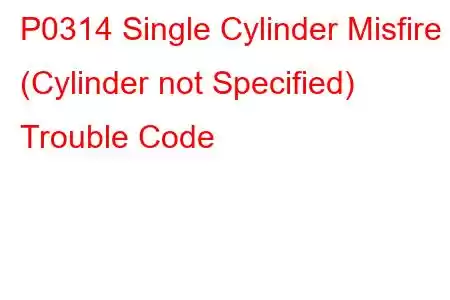P0314 Single Cylinder Misfire (Cylinder not Specified)
OBD-II Trouble Code Technical Description
Single Cylinder Misfire (Cylinder not Specified)
What does that mean?
This generic powertrain/engine diagnostic trouble code typically applies to most manufacturers since 1996.
Those manufacturers include but are not limited to GM, Ford, Dodge, Chrysler, Jeep, Hyundai, Kia, Mazda, Mitsubishi, Volvo and VW.
This code is focused on the relationship between the crankshaft position sensor (CKP), the camshaft position sensor (CMP) and the engine controller (ECM/PCM). The PCM monitors the relationship between these two sensors and compares them to an ideal reference stored in the PCM. If the variation exceeds a calibrated percentage, a fault code is stored. This can be either an electrical fault or a mechanical issue, depending upon the reason for the misfire and the vehicle manufacturer.
Troubleshooting steps may vary depending upon manufacturer and the type of crankshaft position sensor (CKP), camshaft position sensor (CMP) and their wire colors.
Symptoms
Symptoms of a P0314 engine code may include:
Malfunction Indicator Lamp (MIL) on Misfire / bucking or surging Below normal fuel economyCauses
Typically, the causes for this code to set are:
Most Common Issues:
Worn ignition system components, to include the coil, plug wires, spark plugs, etc. Fuel system components - to include the injectorsLeast likely:
Intermittent open in the power, ground or signal circuit to the crankshaft position sensor Intermittent open in the power, ground or signal circuit to the camshaft position sensor Failed PCM - rarelyDiagnostic Steps and Repair Information
A good starting point is always to check for technical service bulletins (TSB) for your particular vehicle. Your issue may be a known issue with a known fix put out by the manufacturer and can save you time and money during diagnosis.
Next, note if there are any other diagnostic fault codes. If any of them are ignition system/fuel system related, diagnose them first. Misdiagnosis has been known to occur if a technician diagnoses this code before any ignition system / fuel system related codes have been thoroughly diagnosed and dismissed. Insure there are no intake or exhaust leaks. An intake leak, or vacuum leak, makes the engine run lean. An exhaust leak gives the impression of a lean running engine by the air/fuel ratio sensor/oxygen sensor (AFR/O2).
After that, clear all diagnostic trouble codes and see if the P0314 returns. If it does not, then the problem was intermittent or the P0314 was a memory code, that is it was something in the past.
If the code resets, that is comes right back the next time you start the vehicle or the very next road test, further inspection is required. Locate the CKP sensor and the CMP sensor on your particular vehicle. Once located, visually inspect the connectors and wiring. Look for scraping, rubbing, bare wires, burned spots or melted plastic. Pull the connectors apart and carefully inspect the terminals (the metal parts) inside the plastic connectors. See if they look burnt or corroded in place of the normal metal color you are probably used to seeing. You can get some electrical contact cleaner and a plastic bristle brush at any parts store if you need to clean the terminals. If this is not possible, find some rubbing alcohol and a toothbrush to clean them with, just make sure you do not put the toothbrush back in the bathroom! Afterwards let them air dry, get some dielectric silicone compound (same stuff they use for light bulb sockets) and put some where the terminals come into contact.
Clear the diagnostic trouble codes from memory again, and see if this code returns. If it does not, then the connections were most likely your problem.
If the code does return, remove the CKP s
Read: 41


